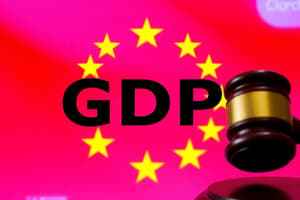Podcast
Questions and Answers
What is the purpose of the Data Protection Impact Assessment?
What is the purpose of the Data Protection Impact Assessment?
- To identify potential risks in data processing
- To ensure compliance with the UK GDPR
- To analyse the data protection risks of a project (correct)
- To appoint a Data Protection Officer
Which legislation modifies the UK DPA 1998 for public bodies and authorities?
Which legislation modifies the UK DPA 1998 for public bodies and authorities?
- UK FOIA 2020
- UK FOIA (correct)
- UK IPA 2016
- UK PECR 2003
What is the role of the Information Commissioner's Office?
What is the role of the Information Commissioner's Office?
- To provide general advice on privacy and data protection (correct)
- To issue fines for non-compliance with the UK GDPR
- To regulate the use of web cookies
- To enforce the EU Cookie Law
What is the purpose of the EU Cookie Law?
What is the purpose of the EU Cookie Law?
What legislation covers data protection in the UK?
What legislation covers data protection in the UK?
What is the relationship between the UK FOIA and data protection?
What is the relationship between the UK FOIA and data protection?
What is the main goal of implementing pseudonymisation in data processing?
What is the main goal of implementing pseudonymisation in data processing?
Under which circumstances can a data controller be exempt from providing data subjects with certain rights?
Under which circumstances can a data controller be exempt from providing data subjects with certain rights?
What is the purpose of the 'Privacy by Design' principle?
What is the purpose of the 'Privacy by Design' principle?
What is the main difference between pseudonymisation and anonymisation?
What is the main difference between pseudonymisation and anonymisation?
Why is a UK GDPR necessary?
Why is a UK GDPR necessary?
What is the purpose of data breach notifications to the authority and data subject?
What is the purpose of data breach notifications to the authority and data subject?
What is the primary purpose of a Supervisory Authority?
What is the primary purpose of a Supervisory Authority?
What is the definition of personal data?
What is the definition of personal data?
What is the role of a Data Processor?
What is the role of a Data Processor?
What is the term for personal data that consists of information about a person's race, ethnicity, or health?
What is the term for personal data that consists of information about a person's race, ethnicity, or health?
What is the right of a data subject to request that incorrect information be rectified, blocked, erased, or destroyed?
What is the right of a data subject to request that incorrect information be rectified, blocked, erased, or destroyed?
What is the purpose of a Subject Access Request (SAR)?
What is the purpose of a Subject Access Request (SAR)?
What is the term for the person or organization that determines the purposes and means of personal data processing?
What is the term for the person or organization that determines the purposes and means of personal data processing?
What is a condition for processing personal data?
What is a condition for processing personal data?
What is the term for the processing of personal data that is necessary to protect the vital interests of the data subject?
What is the term for the processing of personal data that is necessary to protect the vital interests of the data subject?
What is the time period within which organizations must respond to a Subject Access Request (SAR)?
What is the time period within which organizations must respond to a Subject Access Request (SAR)?
Match the following data protection principles with their descriptions:
Match the following data protection principles with their descriptions:
Match the following data privacy rights with their exemptions:
Match the following data privacy rights with their exemptions:
Match the following GDPR compliance requirements with their purposes:
Match the following GDPR compliance requirements with their purposes:
Match the following data breach responses with their recipients:
Match the following data breach responses with their recipients:
Match the following data processing concepts with their descriptions:
Match the following data processing concepts with their descriptions:
Match the following GDPR provisions with their purposes:
Match the following GDPR provisions with their purposes:
Match the following data protection principles with their descriptions:
Match the following data protection principles with their descriptions:
Match the following data privacy rights with their descriptions:
Match the following data privacy rights with their descriptions:
Match the following GDPR compliance requirements with their descriptions:
Match the following GDPR compliance requirements with their descriptions:
Match the following data breach responses with their consequences:
Match the following data breach responses with their consequences:
Match the following data protection terms with their definitions:
Match the following data protection terms with their definitions:
Match the following data protection principles with their descriptions:
Match the following data protection principles with their descriptions:
Match the following terms with their definitions in the context of data protection:
Match the following terms with their definitions in the context of data protection:
Match the following data protection principles with their descriptions:
Match the following data protection principles with their descriptions:
Match the following data protection rights with their descriptions:
Match the following data protection rights with their descriptions:
Match the following data breach responses with their descriptions:
Match the following data breach responses with their descriptions:
Match the following data protection terms with their descriptions:
Match the following data protection terms with their descriptions:
Match the following GDPR compliance requirements with their descriptions:
Match the following GDPR compliance requirements with their descriptions:
Match the following data privacy rights with their descriptions:
Match the following data privacy rights with their descriptions:
Match the following data protection principles with their descriptions:
Match the following data protection principles with their descriptions:
Match the following data protection terms with their descriptions:
Match the following data protection terms with their descriptions:
Match the following data protection authorities with their descriptions:
Match the following data protection authorities with their descriptions:
Flashcards are hidden until you start studying




